For the first time one of my Social Media Tweets has gone *slightly* viral.
https://www.facebook.com/photo.php?fbid=10108204899981461&set=a.10100412680536691&type=3&theater
For the first time one of my Social Media Tweets has gone *slightly* viral.
https://www.facebook.com/photo.php?fbid=10108204899981461&set=a.10100412680536691&type=3&theater
I do not understand why INDThings and Kabir waste their time and energy on arguing with Hindutva.
However there are some Pakistanis that are now verging on the ridiculous:
Why are some Pakistanis demanding a statue of Raja Dahir, the last Hindu king of Sindh?
I didn’t understand the desire to install the statue of the divisive Ranjit Singh. I recently saw the movie Kesari and frankly found it rather offensive that Bollywood chose to celebrate the Slave-soldiers of the Raj rather than the Pashtun freedom fighters.
I do feel a good solution to Pakistan’s identity dilemma would be a constitutional monarchy with Afghanistan (Union of the Crowns, which is what England & Scotland had from 1606-1707).
It would have to be solely Persian-speaking (I haven’t researched enough on what standard of Persian but Dari possibly approximate Sabki-Hind fairly well) but Sunni (in the manner of the Mughals being Sunni, which was eclectic but still distinct enough from the Safavids) and probably the last Afghan dynasty will do with enough Mughal Muslim nobility thrown in for good measure. This would offset the Punjabi-Sindhi dominance since frankly most of the notables would be the traditional ruling tribes of Muhajirs and Afghans (the only royal tribe in Pakistan that comes to mind are the B’s; Brahuis, Baltis and Bahawalpur).
As the last cricket World Cup showed it’s not the Radcliffe line that must be erased; after all it is a civilisational border of sort but rather the Durand line. The fact that Afghanis and Pakistanis were at each other’s throats while the Indians & Pakistanis were super-cordial demonstrates that the former is a familial relationship the latter is a formal one.
There is also a serious possibility that such a constitutional monarchy might have to accommodate the rising tide of Muslim migrants from Modistan.
Then statues of Ranjit Singh and Raja Dahir would make sense as the indigenous expression of Pakistan’s Indian provinces (Punjab & Sindh).
But like all things Pakistani, the national project is still half complete and we must look West to Turan. The Arabs only came once and only manage to transform Sindh; it was the Turanians who reshaped the map of India.
Of course this is constitutional optics and nothing would really change on the ground but the restoration of an Sunni Persian-speaking Afghan-Mughal Monarchy would solidify AfPak and tie it solidly into its Persian & Central Asian neighbours.
It would be a fitting tribute and victory to those noble Afghans who sacrificed their lives at Saraghari under the orders of the British and their Ghulams. Then we can be politically correct and build as many statues of Ranjit Singh & Raja Dahir as we like.
Please keep the other posts on topic. Use this for talking about whatever you want to talk about.
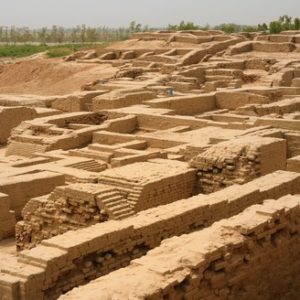 Back in the 2000s, when blogging was a thing, I was at a party and someone mentioned offhand that I had a blog. Someone else blurted out, “Oh, me too!” We left it at that. But a friend asked me why I didn’t let on that my blog got hundreds of thousands of visitors per month, or that millions of people had read me over the years. The point is that there were people who had blogs, and other people who had blogs.
Back in the 2000s, when blogging was a thing, I was at a party and someone mentioned offhand that I had a blog. Someone else blurted out, “Oh, me too!” We left it at that. But a friend asked me why I didn’t let on that my blog got hundreds of thousands of visitors per month, or that millions of people had read me over the years. The point is that there were people who had blogs, and other people who had blogs.
I was reminded of that by this piece in Have We Hit Peak Podcast?. I first heard about podcasting in the middle of the 2000s. I started listening to podcasts around 2008 or so, on my old iPod shuffle. It wasn’t until 2016 that I actually started contributing to my own podcast (on genetics and evolution).
About ten months later we started the Browncast. I’ve now done 67 podcasts for The Insight. I’ve been on the majority of the 50+ podcasts for the Browncast.
So let me quote from The New York Times piece:
But six episodes in, when neither Casper mattresses nor MeUndies had come knocking, the friends quit. Today, Ms. Mandriota says the same D.I.Y. spirit that made having a podcast “alluring” is precisely what doomed the project. “You can talk about the trees outside as much as you want, but if you’re not going to serve listeners and do it in a way that’s engaging, your chances of going viral are low,” she said, calling her show “the most makeshift podcast, with mediocre advice.”
An advice podcast from randoms? On the Browncast you can listen to Shadi Hamid, one of the world’s “top 50 thinkers”, or a conversation with an Indian American getting an arranged marriage. You can listen to discussions about the internecine conflicts in American conservative politics, or a first-person recollection of partition.
The reason there are 50+ episodes of the Browncast is that we have something to say. It’s “peak podcast” for those who don’t have something to say.
If folks over here are not already aware, a major ancient DNA paper on cattle came out last week in the Science magazine. It had an unprecedented 67 ancient cattle samples.
Here’s the abstract,
Genome-wide analysis of 67 ancient Near Eastern cattle, Bos taurus, remains reveals regional variation that has since been obscured by admixture in modern populations. Comparisons of genomes of early domestic cattle to their aurochs progenitors identify diverse origins with separate introgressions of wild stock. A later region-wide Bronze Age shift indicates rapid and widespread introgression of zebu, Bos indicus, from the Indus Valley. This process was likely stimulated at the onset of the current geological age, ~4.2 thousand years ago, by a widespread multicentury drought. In contrast to genome-wide admixture, mitochondrial DNA stasis supports that this introgression was male-driven, suggesting that selection of arid-adapted zebu bulls enhanced herd survival. This human-mediated migration of zebu-derived genetics has continued through millennia, altering tropical herding on each continent.
Well the widespread Zebu presence in the LBA Near East is not exactly a new discovery. It has been known for quite sometime now among archaeologists. This article gives a good overview on the subject.

(Syrio-Hittite Terracota Zebu, source)
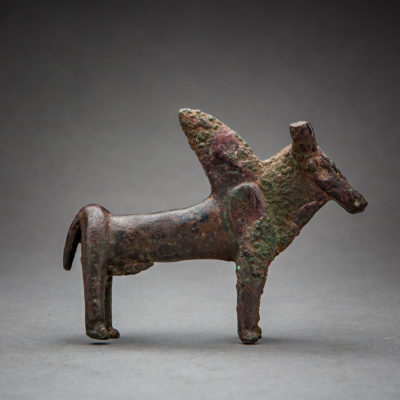
(Hittite Bronze Zebu, source)

Nevertheless, with this new study, we now have conclusive evidence that the widespread Zebu admixture in the Near Eastern cattle did indeed start around 2000 BCE.
(figure courtesy : twitter/johnhawks)
As can be seen from the above figure, after 4000 YBP, there is a sudden spurt in indicine or Zebu admixture across nearly all the ancient samples of Near Eastern Cattle including cattle samples from Central Asia, Iran, the Caucasus, Levant, Mesopotamia & the Balkans.
Again quoting from the paper,
…despite archaeological evidence for contact between civilizations of the Fertile Crescent region and the Indus Valley (9), the influence of the zebu genome is detectable in ancient Southwest Asian cattle only 4000 years later (Fig. 2). However, after ~4000 yr B.P., hybrid animals (median 35% indicine ancestry) are found across the Near East, from Central Asia and Iran to the Caucasus and Mediterranean shores of the southern Levant (table S2 and fig. S1). During this period, depictions and osteological evidence for B. indicus also appear in the region (9, 13). In contrast to autosomal data, but similar to earlier work (14), we find persistence of B. taurus mitochondria, suggesting introgression may have been mediated by bulls (Fig. 2).
As the bolded portions note, the indicine admixture in the ancient cattle samples from the Near East post 4000 YBP, show on an average 35 % indicine admixture but that this mostly through the Indicine bulls as there is indicine mtDNA in these admixed samples. This widespread and major admixture in the Near Eastern cattle post 4000 YBP, is clearly a major turning point in the history of the Near Eastern cattle.
What lead to this major turning point ?
It is now widely accepted that there was a major 4200 YBP climatic event that brought about a prolonged phase of drought perhaps extending to several centuries which affected all major civilizations of the Near East extending all the way to the Indus civilization. This event is also considered a major reason for the apparent ‘collapse’ of the Indus civilization.
Most if not all movements of cattle across large distances in prehistory are usually associated with movement of humans. Did the large influx of Zebu autosomal DNA into the Near East cattle also result due to South Asian population expansion into the Near East post-4000 YBP ?
What we do know from archaeology is that the Harappans were operating across a vast landscape and their presence and influence can be detected in Central Asia, Eastern Iran( Jiroft & Helmand), the SE Arabian coast (Oman & Bahrain) and in Mesopotamia already in the 3rd millenium BC. The Harappans even had their own colonies in these different regions.
It appears that a minority but nevertheless a significant and arguably influential community of Harappans were present in most of these regions away from the Greater Indus region as far as atleast Mesopotamia. Infact, in a lot of these places, the Harappans were apparently living in those places for many generations. It is conceivable that they would have brought and maintained the Zebu cattle in their new homelands.
Therefore, already in the 3rd millenium BC, it is quite probable that the Zebu cattle was already a minor but regular feature of the Middle Asian landscape.
However, after the onset of the 4.2 kya event, with the onset of aridity, it is believed that the Harappan civilization finally collapsed around 3900 kya (1900 BCE). One of the consequences of this collapse is apparently the end of Harappan trade and interaction across Middle Asia.
So the questions is – how did the Zebu admixture in the Near East shoot up all of a sudden in a period when we are led to believe that the Harappan or Indus civilization ceased to interact with this region ?
And it is not just Indian cattle admixture that becomes widespread into the Near East during this post-4000 kya period. As the authors of this paper state,
Westward human migration has been documented around this time(19,20) along with archaeological evidence for the appearance of other South Asian taxa such as water buffalo and Asian elephants in the Near East(21), suggesting the movement of large animals by people.
Infact, the presence of Asian Elephant in the Near East dates to from the end of 3rd millenium BC to the 8th century BC and is centred around Syria and hence this ancient elephant population is also known as the Syrian Elephant.
The authors of the study cited on Asian Elephants in our cattle aDNA paper above state something very interesting,
…ancient accounts indicate that live elephants roamed and were hunted in the Orontes Valley, the Upper Euphrates Valley and the Middle Euphrates Valley around modern Ana in Iraq, at least between the end of the 16th and 9th centuries BC, possibly into the 8th century BC (Breasted 1906–07; Gardiner 1964: 179, 201; Moorey 1994: 117; Scullard 1974: 28). The core of this region comprises the area of influence of the Mitanni Kingdom, the main local political player in LBA northern Syria…
The Mitanni were an Indo-Iranian, possibly Indo-Aryan elite ruling over the native Hurrian population in present day Syria in the mid 2nd millenium BCE. And we observe that Asian Elephants, most likely imported from the Indus civilization, only appear in the Near East during the 2nd millenium BC and in a geography that was under the political control of the Mitanni. Is this merely a co-incidence ?
It is quite probable that with the collapse of the old Bronze Age empires all across the Near East and South Asia, this entire Middle Asian region entered into a new era of interaction which is archaeologically not so well-defined. The widespread Zebu admixture in the Near Eastern cattle along with the presence of Asian elephants as also the first attestations of the Indo-Europeans such as the Hittites & the Mitanni and the associated horse-drawn chariots are evidences of this new horizon.
But while the Zebu and the Asian Elephant came from South Asia, one may argue that the Hittites, Mitanni and the horse drawn chariot must surely come from the steppe.
Well, the strong correlation of the geography of the LBA ‘Syrian’ Elephant population with the boundaries of the Mitanni empire, does suggest some sort of interaction of the Mitanni with South Asia.
And if this is not all, we have now possibly a very strong evidence of the presence of chariots in South Asia which is as old and probably older than the Sintashta chariots in the steppe.
It maybe noted that before the discovery of the chariots in Sintashta which gave the steppe chariot the distinction of being the oldest known one, it has been argued for long that the invention of chariot is mostly likely in the Near East and not in the steppe due to several factors inimical for the use of chariots on the steppe. You can read more about it here.
The discovery of the Sanauli chariots is likely to revive that debate. Along with this, we also have the prospect of horse aDNA from the Mature Harappan Phase no less.
Genetic evidence of Horses in mature Harappan period. The findings will be published soon.
— Niraj Rai (@NirajRai3) January 8, 2019
So could the appearance of the Zebu, the Asian elephant, the Buffalo as well as the Hittites & Mitanni and their horse drawn chariot in the 2nd millenium BC in the Near East have a common cause in their probable migration from South Asia after the Indus civilization collapse.
Certainly some food for thought !
I recently participated in an interaction on policy, democracy and reform movements in the light of a major event in British history – the Peterloo Massacre, 1819, in the Palace of Westminster, London, in the evening of 17th July 2019. The Massacre took place at St Peter’s Field, Manchester, on 16 August 1819, when cavalry mainly comprising of the 15th The King’s Hussars (who had been pivotal in the Napoleonic Wars, particularly the Battle of Waterloo) charged into a crowd of 60,000–80,000 who had gathered to demand the reform of parliamentary representation. They were led by the fiery radical reformer Henry Hunt. After the stunning barbarism on the part of the administration, 18 were reported died while hundreds were injured.
[…]
Following the Peterloo Massacre, the government of the United Kingdom acted to prevent any future disturbances by the introduction of new legislation, the so-called Six Acts aimed at suppressing any meetings for the purpose of radical reform. Even though the regressive Pittite Acts were struck down over two centuries (with the most recent repeal being as recently as 2008), what fascinates me is how the Rowlatt Act that led to the Jallianwala Bagh massacre in Punjab, India, a century later has resonances with the Six Acts.
Read more on this here: https://lincogle.wordpress.com/2019/07/18/peterloo-and-jallianwala/
India attained its independence from the British Raj on 15 August 1947. Curiously, within less than a decade, it was back in shackles. The white sahab was replaced by the brown babu. The Viceregal Palace was renamed Rashtrapati Bhavan. Names of a few cities were desi-fied. Bombay became Mumbai, Calcutta became Kolkata and strangely Madras became Chennai! But certain structures of oppression and hierarchy in society still remained. Certain ideas of what it meant to be Indian remained. Ideas that created conceptual constructs that created philosophies and even politics. India was birthed in a chaotic backdrop, with Partition and its after-effects. Even as a fledgling country trying to make sense of itself, India never quite had a problem with the diversity of its constituents. Unity in diversity became a catchphrase and a cornerstone of what it meant to be Indian. Tolerance and pluralism came to India as easily as breathing was to man. Spontaneous. Simple. Founded on centuries, nay millennia, of assimilation and churning of cultures, philosophies, ideas and people.
And then the undercurrents of differences burst forth, breaking the dams of reason, tearing asunder the fabric of Indian society.
Read more about a Dharmic take on identity politics here: https://lincogle.wordpress.com/2019/07/08/a-struggle-for-true-liberation/. #Solidarity
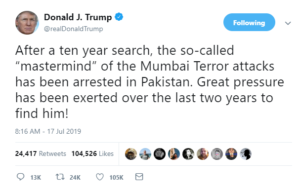
Pakistan has (once again, for the nth time) arrested Hafiz Saeed . This time the charge is “terror financing”. It should be clear to anyone who bothers to read a few newspapers that he was not hiding anywhere and did not need to be “found”. He has always lived and worked openly in Pakistan and this is not the first time he has been arrested (and may not be the first time he is let go after the dust settles and the IMF funds arrive). It is also worth noting that the charges have nothing to do with the Mumbai attacks and that the current military regime in Pakistan will not even admit that those attacks came from Pakistan. In fact their vast PR apparatus has successfully convinced many educated Pakistanis that the whole thing was an Indian (or Israeli) false flag operation and the attackers did not even come from Pakistan. While this is not the official stance of the government of Pakistan (which actually investigated the attackers to some extent under international pressure, and produced detailed evidence linking the attackers to Pakistan, including details such as where the boat was purchased and such like, and several people have been in jail at some point for their involvement in this attack), the domestic propaganda and management of witnesses etc has been so effective that I regularly get whatsapp messages from friends “accusing” some Pakistani journalist or TV station of being Indian agents because they have said at some point that the sole surviving terrorist (Ajmal Kasab) was a Pakistani. As an aside, it would be interesting if someone can ask a senior member of the current military regime to publicly state on record that Ajmal Kasab was Pakistani. I doubt that anyone (except maybe Trump) can actually do this (i.e. I doubt that any senior official can come on TV and admit this.. it would be too far at variance with the domestic propaganda that ISPR has put out).
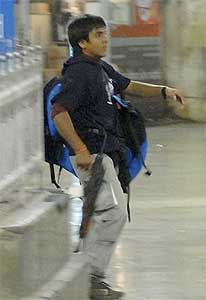
In 2014 Hafiz Saeed actually held a conference of his (renamed) Jihadi organization at the “minar e Pakistan” (Pakistan memorial) in Lahore and rode around on a horse to feel close to the spirit of the original Arab conquerors he idealizes.
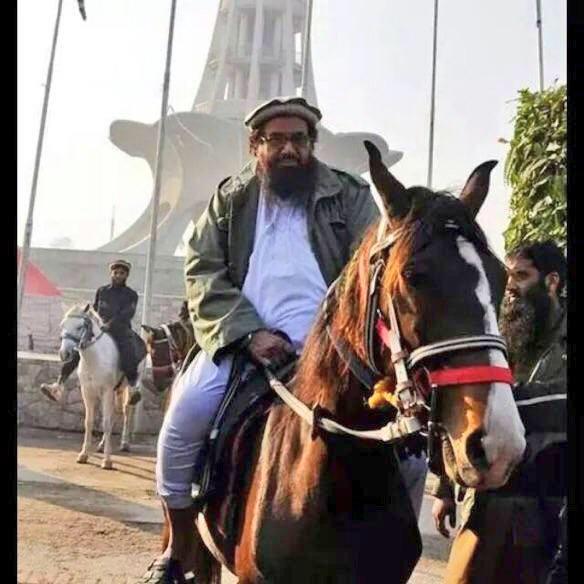
So anyway, everyone knew where Hafiz Saeed was, and even this latest arrest does not mention the Mumbai attacks, so either Trump is remarkably ignorant (possible) or he is just playing to his base, who love the whole “Western” movie ethos of wanted posters, dead or alive, manhunt, etc and finally, Sheriff Trump riding to capture the “bad guys”. I find it hard to believe that even Trump can be ignorant enough to not know all this, so I vote for “bullshitting his base” as the most likely explanation for this tweet.
But while all this may be just show to get Pakistan off the FATF hook and to get some much needed cash (and maybe even weapons) from Trump, it is still hard to say who is conning who here. At one level Pakistan has “successfully” conned the US for 17 years and received billions in aid while supporting the Taliban and hosting multiple other Jihadi organizations. But it is hard to see this as a “win” for Pakistan. While Pakistan’s military regime (and this issue has ALWAYS been handled by the army, no civilian was allowed to butt in.. Mian Nawaz Sharif lost power for trying to minimally rein in this policy) has played these games and thinks it is winning, it has actually presided over Pakistan falling steadily behind India and even Bangladesh in every economic and social indicator. It would have been much better to swallow the bitter pill in 2001 and actually switch sides and give up on Jihad. By now Pakistan would be outperforming rickety India and even “rising star” Bangladesh in many areas. Instead, we have wasted a generation trying to play these games and may not have anything to show for it if this round of show arrests does not even get us off the FATF grey list (or worse, gets us on the blacklist).
Indians are (unsurprisingly) not delighted with this latest show of successful Pakistani conmanship (or even genuine change of heart), but in the proverbial long run, who gets the last laugh? India, a rising economic power in the world, or Pakistan, playing strategic games with multiple sponsors and just staying half a shaky step ahead of its multiple creditors?

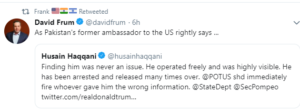
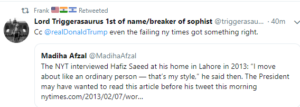
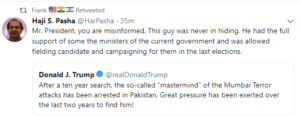

Another BP Podcast is up.
It was our crew of usual suspect; Vidhi, Kushal, MJ, Jahanara and myself. We spoke about Ms. Mahua Moitra; who is, to my mind, Alexandria Ocasio-Cortez reimagined as Lady Durga.
I frankly find the anti-elitist elements expressed in the podcast to be rather disconcerting. Even though V and I don’t necessarily agree; we are probably united in our interest in aesthetes.
I find Ms. Moitra to be enchanting and alluring in a way I don’t find Smirti, Sonia or Sushma. It helps that Mahua speaks with a Convent school-liberal arts-Investment Banker mannerism; makes her even more compelling.
You can listen on Libsyn, iTunes, Spotify, and Stitcher. Probably the easiest way to keep up the podcast since we don’t have a regular schedule is to subscribe at one of the links above.
You can also support the podcast as a patron. The primary benefit now is that you get the podcasts considerably earlier than everyone else. Razib is toying with the idea of doing a patron Youtube Livestream chat, if people are interested, in the next few weeks.
Would appreciate more positive reviews!
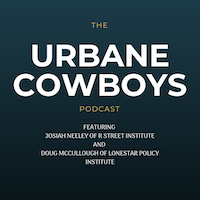 Another BP Podcast is up. You can listen on Libsyn, iTunes, Spotify, and Stitcher. Probably the easiest way to keep up the podcast since we don’t have a regular schedule is to subscribe at one of the links above.
Another BP Podcast is up. You can listen on Libsyn, iTunes, Spotify, and Stitcher. Probably the easiest way to keep up the podcast since we don’t have a regular schedule is to subscribe at one of the links above.
You can also support the podcast as a patron. The primary benefit now is that you get the podcasts considerably earlier than everyone else. I am toying with the idea of doing a patron Youtube Livestream chat, if people are interested, in the next few weeks.
Would appreciate more positive reviews!
On this episode, I talk to Josiah Neeley and Doug McCoullough. Hosts of the center-Right Urbane Cowboys podcast, they have had Reihan Salam, Avik Roy, Ramesh Ponnuru, and myself, as guests. They do the “brown representation” well, in other words.
Most we talk about the French-Amhari wars. All of us stake somewhat different positions on this conflict within modern conservatism and try to hash out a path to the future.f